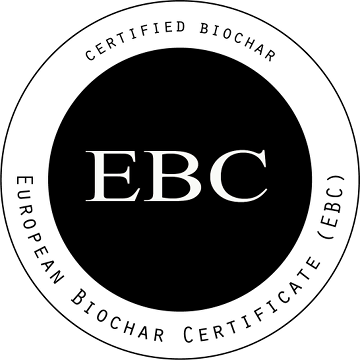Summary of the EBC certificiation
- Production batch
- A production batch starts with its registration on the EBC website. The production batch receives a unique ID number and QR code.
- A production batch lasts a maximum of 365 days including all possible interruptions in production.
- Within the first 2 months after registration of a production batch, a representative sampling has to be carried out by an accredited sampler which is usually the same person as the controller sent by the inspection body bio.inspecta AG.
- The pyrolysis temperature in °C shall not change by more than 20% during production. At a declared pyrolysis temperature of, for example, 600 °C, short-term fluctuations between 480 °C and 720 °C are thus permitted.
- The composition of the biomass must not change by more than 20%. If, for example, a mixture of 50% grain husks and 50% landscape conservation wood is pyrolysed, the proportions may vary in the range 40% to 60% (±(50% x 20%) = ±10%).
- After a production batch has expired, a subsequent, new production batch must be registered on the EBC website.
- Sampling and sending the sample for analysis
- The representative sample of a production batch is taken during the initial audit and thereafter during each annual inspection by an accredited sampler in accordance with the sampling plan contractually specified in the initial audit and sent to an EBC accredited laboratory.
- The biochar producer selects an EBC accredited laboratory.
- In accordance with the sampling and quality assurance plan specified in the contract, the production company shall ensure the sampling and sealed storage (usually daily) of the retained samples.
- Usable biomass for the production of biochar
- All biomasses included in the EBC Positive list may be used individually or in combination as feedstock for the production of EBC biochar. For each class of application certain restrictions apply, which are set out in the EBC Positive List. For example, not all biomasses that may be used for EBC-Feed may be used for EBC-materials. Within a batch, the type of biomass may not be changed and the mixing ratios may not change by more than 20% (cf. 2.5).
- Mineral additives according to the EBC Positive List may be added up to 10% of the mass. No mineral additives are permitted for EBC-Feed.
- Specifications for pyrolysis technology
- The use of waste heat or the use of liquid and gaseous pyrolysis products must be ensured.
- Nationally defined emission limit values must be complied with.
- Properties of biochar
- The biochar for all application classes (Feed, AgroBio, Agro, Material) must be analysed at least according to the EBC Basic Analysis Package. For EBC-Feed the analyses of the EBC-Feed package are additionally required.
- The following limit values must be observed:
|
EBC - Label EBC - Class |
|
EBC-Feed Class I |
EBC-AgroBio Class II |
EBC-Agro Class III |
EBC-Material Class IV |
|
Elemental analysis |
C-total, Corg, H, N, O, S, ash |
||||
|
|
H/Corg |
< 0,7 |
< 0,7 |
< 0,7 |
< 0,7 |
|
|
O/Corg |
< 0,4 |
< 0,4 |
< 0,4 |
< 0,4 |
|
Physical parameters |
Water content, dry matter (DM), bulk density (TS), specific surface area (BET), pH, salt content |
||||
|
TGA |
Only once for the first production batch of a pyroylsis unit |
||||
|
Nutrients |
at least N, P, K, Mg, Ca |
||||
|
Heavy metals |
Pb |
10 g t-1 (88%DM) |
45 g t-1 DM |
150 g t-1 DM |
250 g t-1 DM |
|
|
Cd |
1 g t-1 (88% DM) |
0.7 g t-1 DM |
1,5 g t-1 DM |
5 g t-1 DM |
|
|
Cu |
100 g t-1DM |
70 g t-1DM |
100 g t-1 DM |
250 g t-1 DM |
|
|
Ni |
30 g t-1 DM |
25 g t-1 DM |
50 g t-1 DM |
250 g t-1 DM |
|
|
Hg |
0.1 g t-1 (88% DM) |
0.4 g t-1 DM |
1 g t-1 DM |
1 g t-1 DM |
|
|
Zn |
400 g t-1 DM |
200 g t-1 DM |
400 g t-1 DM |
750 g t-1 DM |
|
|
Cr |
80 g t-1 DM |
70 g t-1 DM |
90 g t-1 DM |
250 g t-1 DM |
|
|
As |
2 g t-1 (88% DM) |
13 g t-1 DM |
13 g t-1 DM |
15 g t-1 DM |
|
Organic contaminents |
16 EPA PAH |
4±2 g t-1 DM |
4±2 g t-1 DM |
6.0+2.2 g t-1 DM |
30g t-1 DM |
|
|
Benzo[a] pyren |
25 mg t-1 (88% DM) |
|
||
|
|
PCB, PCDD/F |
see chp. 9 |
Once per pyrolysis unit fort he first production batch |
||
- Health and safety
The workers must sign that they have been informed about possible dangers at the workplace and that they have the necessary protective clothing.


